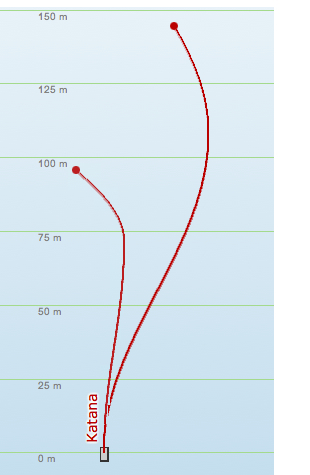Disc Golf Flight Information
On our website all the discs are displayed with their associated Flight Rating Numbers (Innova Flight Rating System) and their Flight Path Stability.
Describing Flight Rating Numbers:
Flight Ratings are divided into four main categories: SPEED, GLIDE, TURN, & FADE. These characteristics can be used to rate various aspects of each disc's flight path stability. Each disc has a distinct flight path that makes that disc unique. Flight Ratings can be used to compare between different discs*. Once you have thrown one disc you can use the flight rating numbers to compare it to any other disc models*. To learn more about what each of these characteristics mean, refer to the description below.
SPEED: Speed is the ability of the disc to cut through the air. Speed Ratings are listed from 1 to 14. Discs with high numbers are faster. Faster discs go farther into the wind with less effort. Slower discs take more power to throw, but have less of a chance to fly past the basket.
GLIDE: Glide describes the discs ability to maintain loft during flight. Discs with more glide are best for new players, and for producing maximum distance (especially downwind). Glide is rated from 1 to 7. Beginners looking for more distance should choose discs with more glide.
TURN: High Speed Turn is the tendency of a disc to turn over or bank to the right during the initial part of the flight (For Right Hand Backhand throws)**. A disc with a +1 rating is most resistant to turning over, while a -5 rating will turn the most. Discs rated -2 to -5 make good roller discs.
FADE: Low Speed Fade is the discs tendency to hook left (For Right Hand BackHand throws)** at the end of the flight. Fade is rated from 0 to 5. A disc rated 0 will finish straightest, while a disc rated 5 will hook hard at the end of the flight. Discs with a high fade rating are predicable even in wind.

The chart above describes the effect of different throw SPEED on a disc flight path.
Innova Katana - SPEED 13, GLIDE 5, TURN -3, FADE 3
Right hand side: Expert throw - Disc fly at Maximum SPEED (13) to its full distance potential.
Left hand side: Amateur throw - Disc fly at Less SPEED (9), therefore not achieving its high speed TURN. The result is significant less distance with much more FADE.
Always choose a disc to match your ability level
(Arm Speed & Technique)
Describing Disc Flight Path Stability:
Stability is the measurement of a disc's tendency to bank laterally during its flight. A disc that is overstable will tend to track left (for a right handed, backhand throw), a disc that is stable will remain straight through most of the flight, and a disc that is under-stable will tend to track right (also for a right handed, backhand throw). The stability rating of the discs differs depending on the manufacturer of the disc. Innova Discs rate stability as TURN and FADE on a scale of +1 to −5, where +1 is the most overstable and −5 is the most understable. TURN references how the disc will fly at high speed during the beginning and middle of it flight. FADE references how the disc will fly at lower speeds towards the end of its flight. Ex. A disc with a turn of -4 and fade of +1 will fly to the right for (right handed, backhand throw) the majority of its flight then curl back minimally left at the end. A disc with a turn of -1 and a fade of +4 will turn slightly right during the middle of its flight and turn hard left as it slows down. Discraft stability ranges from 3 to −2 for Discraft discs (3 being most oversable and -2 being most understable). Discraft's ratings are more of a combination of turn and fade with the predominance being fade.
Other Factors That will Effect Disc Stability:
Weight Effect on Stability: The weight of a disc can also affect its stability. The rule of thumb is: a heavier version of any given disc will tend to be slightly more overstable than a lighter version of the same disc.
Plasic Blend Types Effect on Stability: On many occasions manufacturers will produce the same disc mold in a variety of plastic blends. Different plastic blends will affect the overall stability of the same disc mold. There will be minor differences in flight numbers ratings within the same mold, when made from different plastics blends. In addition, the more durable plastic blends will retain flight numbers ratings for a longer period of time. For full information on all the different plastic blends, please refer to each manufacturer plastic type’s information page.
* Flight ratings are not meant to describe the exact flight of any disc model. They are to be used to compare between models. For instance, a disc rated at 11, 5, -1, 3 is a faster type than the 10 speed models and slower than the 12 and 13 speed models. The Glide, Turn, and Fade cannot be compared to other speeds, but can be compared to other discs at the same speed.
** Please note: All of our discs flight numbers rating are based on players throwing right-handed with a back hand style (RHBH).
-
For Left Hand Backhand Throw (LHBH) – Reverse the RHBH flight characteristics (mirror image).
- Right Hand Forehand Throw (RHFH) – Reverse the RHBH flight characteristics (mirror image).
- Left Hand Forehand Throw (LHFH) – Same flight characteristics as a RHBH throw.
